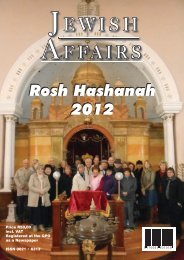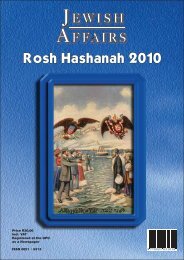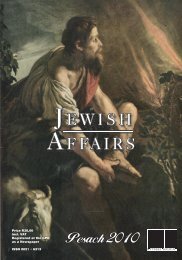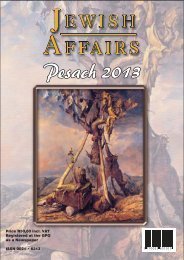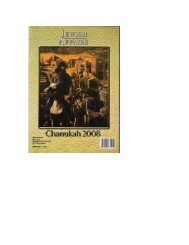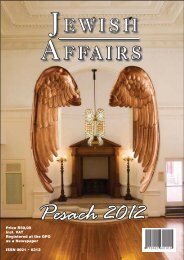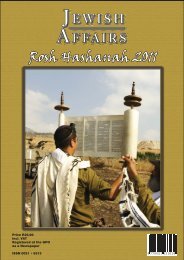Rosh Hashanah 2009 - South African Jewish Board of Deputies
Rosh Hashanah 2009 - South African Jewish Board of Deputies
Rosh Hashanah 2009 - South African Jewish Board of Deputies
- No tags were found...
You also want an ePaper? Increase the reach of your titles
YUMPU automatically turns print PDFs into web optimized ePapers that Google loves.
JEWISH AFFAIRS ROSH HASHANAH <strong>2009</strong>Within a fortnight the first contribution <strong>of</strong> £8 17s 6dwas received. 1 Yet notwithstanding institutionalsupport and that <strong>of</strong> the wealthier patrons, it was notedat a meeting in May 1912 that the majority <strong>of</strong> thesubscribers came from the poorer section <strong>of</strong> thecommunity, proving how necessary this institutionwas to Cape Jewry at large. Anyone donating £50 ormore was eligible to endow a bed that would bear aplaque bearing the donor’s name. The beds, however,could only be endowed in the name <strong>of</strong> living people;the names <strong>of</strong> those deceased person would beinscribed on a Memorial <strong>Board</strong> at the entrance.The task <strong>of</strong> finding a suitable house was not easy.Committee President Joseph Kadish <strong>of</strong>fered a housethat he owned in Mill Street, but it did not have anygrounds and with the shop attached could onlyaccommodate between 12 and 14 children. 2 A housein Hatfield Street belonging to the Cape Town HebrewCongregation that could accommodate fifty orphanswas initially favored, but it was considered to be toocentral and the congregation was not agreeable. 3 Acertain Louis Elias, a member <strong>of</strong> the Grand Order <strong>of</strong>Israel, <strong>of</strong>fered a plot 80’ by 100’ in Upper MillStreet. 4 This <strong>of</strong>fer, which was bound to the conditionthat the ground only be used for an orphanage, wasfinally abandoned. 5As no other houses were available, it was decidedto use Kadish’s Mill Street house from 11 December1911. 6 Renovations were immediately set in motionand the house was soon equipped by generousdonations <strong>of</strong> linoleum, furniture, beds linen, toys,and books. The Orphanage was opened in February1912 by Colonel David Harris. Colonel Harris, whilebeing deeply sensitive to the complement paid tohim, “regretted that such an institution was not keptby the state” and that, as it was sectarian, it wouldonly be supported by the <strong>Jewish</strong> community. Still he“hoped that they would receive outside support, asthe Jew had always proved himself to be a reliever <strong>of</strong>human suffering.” 7By June 1913, the house in Mill Street wasrunning out <strong>of</strong> space. 8 It was proposed that plansshould be put forward for the erection <strong>of</strong> a buildingthat could accommodate fifty orphans. 9 Two plotswere considered: the first was in Upper Mill Streetthat could be leased from the Cape Town Municipalityat a nominal fee, and the second was in MontroseAvenue in Oranjezicht, that was far more expensivebut could be bought outright. Reservations wereexpressed about the possible penetration <strong>of</strong> Coloredsinto Upper Mill Street, as well as the possibility <strong>of</strong>the area becoming more industrial. It was decidedthat the Oranjezicht plot would be the better asset,and it was duly purchased. 10 <strong>South</strong> Africa GovernorGeneral Lord Buxton laid the foundation stone <strong>of</strong> thenew building. 11With the flue epidemic <strong>of</strong> 1918, an extension tothe building was envisaged. 12 The following year, itwas reported that there was space for another threemore boys and six more girls. 13 In January 1920, ascheme was outlined to build on two extra wings thatwould each be able to accommodate thirty sixchildren. 14 In February 1921, just before the arrival<strong>of</strong> the Ukrainian orphans, it was reported that therewere 51 children from 19 different families in thehome. 15Even before advertisements were put in the paperfor applicants, the committee made sure to ascertainwhether there were any <strong>Jewish</strong> orphans who werebeing kept at any <strong>of</strong> the Christian orphan asylums inthe city, such as the St John’s Home, Nazareth Houseor the All Saints Home. One <strong>Jewish</strong> girl was locatedResidents <strong>of</strong> the Cape <strong>Jewish</strong> Orphanage, as they appeared in a <strong>Rosh</strong> <strong>Hashanah</strong> fundraising, 1920.20



